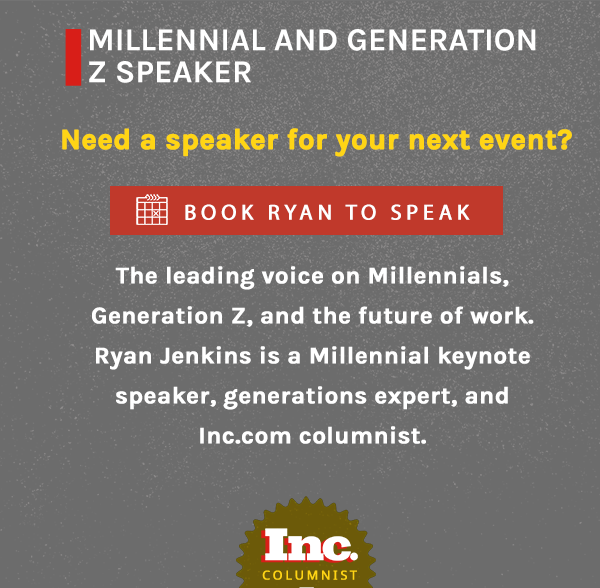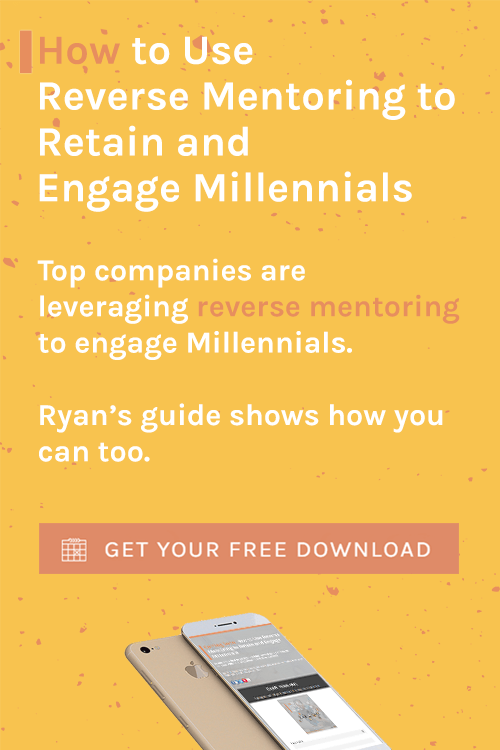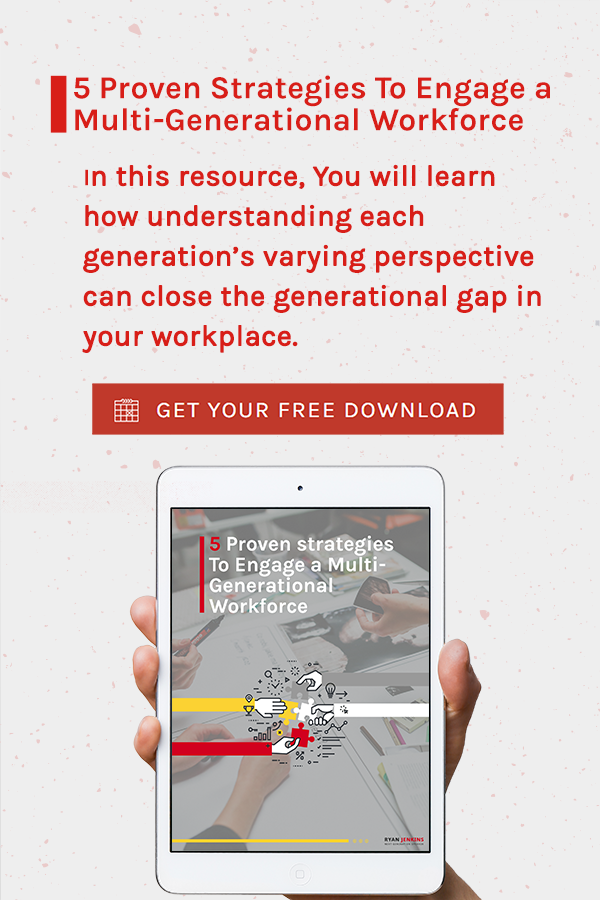Here are five actions leaders can take to help Millennials engage at work by putting down their device.
Humans have a past with resisting change.
Around 370 BC, Socrates warned against writing because it would "create forgetfulness in the learners' souls, because they will not use their memories." People railed against the first newspapers, arguing that it socially isolated readers and would erode face-to-face communication. When radio and television arrived, many were fearful that it would distract children, diminish performance in school, and turn their brains to mush.
Today we have an endless on-demand combination of writing, radio, and television all rolled into one...smartphones. If anyone was going to be concerned about forgetfulness, social isolation, distraction, and mushy brains, it would be today.
Creating healthy limits around mobile devices couldn't be more important as augmented reality and virtual reality--forecasted to generate $150 billion in revenue by 2020--become more mainstream. The next generation of employees will have to strike the right balance between interpersonal skills and participating in the most immersive virtual worlds humanity has ever seen.
But that's easier said than done. Technology is addicting, especially for Millennials who grew up on it and have created a stronger dependence on it than other generations.
Science tells us that the ding of our devices releases dopamine in our brains. Dopamine is a neurotransmitter that helps control the brain's reward and pleasure centers. Dopamine is the same chemical that is released when smoking, drinking, or gambling. It's addictive because it's a pleasurable brain sensation.
Just like an alcoholic will turn to the bottle during stressful times, Millennials turned to mobile devices and social media during the stressful and confusing times of their adolescence. This created a sense of security and dependence on technology that many of them still carry with them as young professionals. Today many Millennials abuse mobile and are addicted to social media. Too often mobile has become a crutch, a mindless escape to consume instead of a tool for creation or to enable productivity.
Remember when companies offered their employees a "smoke break?" For Millennials, Snapchat is the new smoke break.
However, Millennials aren't the only guilty party. Every generation's digital behaviors are infringing on the opportunity to create a genuine human connection. A recent report from the media information and analysis company, Nielsen, found that Generation X spent the most time using social media (six hours and 58 minutes per week), followed by Millennials (six hours and 19 minutes per week), and then Baby Boomers (four hours per week).
As the world goes mobile, it's critical to not vilify mobile but find ways to manage it instead of it managing you. We must ensure today's tech tools are not limiting our focus and connection with others. Because on the other hand mobile will be the lens in which we interact with the future world. An artful, tricky balance between using and abusing must be struck.
Technology isn't bad, just like gambling is bad. The imbalance is hazardous. Too much gambling is dangerous. Too much technology is unhealthy.
Balance is best and finding the right balance starts with leaders.
5 Actions Leaders Can Take to Help Millennials Put Down the Device
1. Model
Today's best leaders are double threats. They leverage technology for enhanced learning, productivity, and influence while maintaining strong offline communication skills in order to listen, collaborate, and inspire. A healthy balance of mobile device use is critical in establishing the necessary credibility and capability to lead in a hyper-connected world.
To effectively influence Millennials' mobile device usage, a leader must have their own mobile usage under control and in good balance. Leaders have to appreciate (and use) the power of mobile, the pitfalls of too much or inopportune usage and integrate it successfully.
Asking Millennials to "get off their phone," will only create resentment and position the leader as irrelevant or outdated. Speaking from a place of authority and credibility is crucial if Millennials are going to listen and/or take you seriously.
2. Track
Encourage Millennials to take an active role in monitoring how much time is spent on their device. Ironically, there are apps to help individuals track their smartphone use. Encourage the use of the below tools so that Millennials can take back their productivity.
- Checky - tracks how many times users turn on their phone in a single day.
- BreakFree - incorporates the usage tracking features found in many similar apps, but it differs in that it breaks down the information into an easy-to-understand "addiction score."
- Offtime - helps users unplug by blocking distracting apps and/or games and filtering communications.
- Forest - a gamified app where users are rewarded by the growth of a virtual tree for not touching their phone.
- Moment - tracks users device usage and allows users to set daily limits; the app notifies you if you exceed them.
- Flipd - allows users to lock their phone for a set period of time, without the option of unlocking once the limit has been set.
- AppDetox (Android App Store) - users can set their own parameters on an app-by-app basis so users can still access at the appropriate time.
- UnPlug (iOS App Store) - users can monitor their daily device usage, explore the results, set daily limits, and earn rewards for cutting back.
- Freedom - a cross-platform application that lets users set a list of distracting sites, then block them either on a schedule or during sessions that users turn on at will.
These tools will help Millennials quantify the magnitude of their addiction or dependence on their device. Gaining personal buy-in is important in order for Millennials to take the necessary steps in correcting their unproductive and unfocused behaviors.
3. Emphasize
Use the results of the tracking as an opportunity to emphasize the purpose, perks, and power of disconnecting. Take time to emphasize messages like...
- Often just the presence of a device in your hand or on a table, can cause an invisible barrier between you and the other person.
- Good at putting filter on things (Facebook and Instagram). Life is amazing even though I'm depressed.
- The constant distractions offered by a device limit innovation and ideas. Uninterrupted thoughts and conversations spur greater creativity.
Emphasize the purpose, perks, and power of disconnecting through your actions...
- Give them a glimpse of what real connection feels and looks like.
- Make them see and feel what it's like to have undivided attention, uninhibited by a device.
- Deliver unexpected experiences or through-provoking questions that result in genuine curiosity.
4. Trial
Once mobile dependence is quantified and verified (and the power of disconnecting to connect is communicated) by an individual, leaders can take steps to set-up the necessary boundaries or guidelines. Consider trialing a specific mobile-free zone in the office, a no-mobile hour, or a mobile-free lunch. Model or encourage participation in the trials but never mandate.
After the trial, ask employees what their results or outcomes were from participating in the trial. Adjust the trial accordingly or consider turning the trial into a permanent part of the workplace or company culture.
5. Balance
Mobile devices are a new staple in the fabric of life. Going back to a post-mobile workplace is impossible in a world where there are more active mobile devices than people. For Millennials who will be using mobile for the rest of their lives as their wallet, map, key, camera, phone, etc...expecting them to ditch mobile isn't realistic nor a productive long-term solution.
We are living through an era of mobilization so it's important that you be an advocate of mobile and play your part in helping them master the tool. If there are specific work related tasks that Millennials can perform better or faster on a mobile device, then consider folding it into the process and/or making it a best practice for the team.
Balance is best and a must.
(This is 1 of the 47 strategies Ryan shares in his new book, The Millennial Manual: The Complete How-To Guide to Manage, Develop, and Engage Millennials at Work.)
Consider Ryan Jenkins to be your next Millennial or Generation Z keynote speaker by clicking here...
![]()
This article was originally posted on Ryan's Inc.com column, Next Generation Insights.






